Maria Manola
Associate Professor, Department of Tourism Management, University of Western Attica
Anna Irini Tsatalbasoglou
Doctoral Candidate, Department of Tourism Management, PA.D.A.
Stavros Kamaroudis
Associate Professor, University of Western Macedonia.
Abstract
This article presents the most important milestones in the life of the lyric poet Sappho. It aims, by examining the importance and impact of the poetess, to make proposals for economic development that will improve tourism and contribute to the local economy. Through a journey through the places where Sappho was born, lived, loved, created and died, as well as photographic documentation of works that depict Sappho, the study focuses on proposals to highlight the places that the poetess walked, such as cultural routes, creation of a theme park in Eresso, utilization of historical heritage etc.
Cultural, as an alternative form of tourism, as mentioned by Manola (2019), has as its main tourist activity the enjoyment that arises when a traveler comes into contact with the culture of a destination, gets to know it and learns about it.
Poetry is one of the most important manifestations of cultural production and Greece, a country that gave birth to many writers and poets whose works are highly regarded, has drastically influenced the world in this field. Among all of them, Sappho shines, a woman, a poet whose works are heirlooms, have stood the test of time, moved and continue to move readers.
Keywords: Lyric poetess, Sappho, economy, cultural routes, theme parks.
Psapfa[1], life and resonance
He was born in Eresos on Lesbos around 630 BC. From her references to her brother Larichos, who served as winemaker in the rectory of Mytilene, we infer that he came from a wealthy family, as winemaker status was an office reserved for good-looking young men from good families. He received an excellent education and became a master of the lyre. According to Takaris (1995), it is considered possible that she was married to a rich man from Andros, from whom she even had a daughter, Kleida, "my golden flower", as she mentioned in her poem.
He was one of the main exponents of the transition from epic to lyrical poetry, perhaps the most famous and most widely read poetess of the ancient Greek world, creator of the Aeolian lyrical tradition which constitutes pure poetry. Her originality lies in the fact that she dared to talk about personal feelings and the world of dreams. The fragments of her works testify to a tender poetry with an emotional content, full of references to simple everyday elements, characterized by delicacy and tenderness. (Kalatzis, 2017)
Aristophanes attributes to Sappho characteristics of a Muse and refers to her face with particular admiration. Her poetry survived through references to her person because social issues such as the issues of gender equality, women's sexual emancipation or the rescue of women's written production were presented through her poems.
According to Giannikou (2010), Sappho's chamber poems influence corresponding wedding scenes in many comedians of the Ancient Comedy and especially in the Aristophanic work, where Sappho acquires a dual status of courtesan at the same time as that of the Muse. In the social and anti-war works of Aristophanes, Sappho becomes an inspiration, reduced to a Muse, mythologized and connected to the primordial cult of fertility.
But Sappho's influence continues, as Giannikou (2010) mentions, also during the Byzantine period, where her themes about wedding songs spread her poetry because they are reproduced in novels and also in popular tradition, as descriptions of wedding procedures such as the offering of incense appear , the gifts, the wedding songs, the dances, the dowry, the bride's gifts, the reception they prepare and the bride offered to the groom as a prize of love.
IIlaton had written that she was the tenth muse, while Alcaeus had characterized her as a "holy woman". To this day, Sappho is recognized by the whole intellectual Western world as "the woman who wrote the best poetry ever written". She is considered to be the one who described love and praised it with the seriousness and passion of a genius. He managed 2,600 years ago to express the feeling with the help of imposing images and figures of speech such as metaphor, simile and contrast, transforming the passion and admiration for the feminine nature into lyrical poetry and even into Aeolian dialect, lending them among others to her works a melodic dimension.
With the passage of time, the view of Sapphic poetry changes according to the attitude that society had towards sexuality. Thus in antiquity her work was deified, in the early Christian years her poems were burned at the stake, while during the Renaissance they were rediscovered and handed down to the next generations.
Because Sappho has nowadays been associated with the LGBT+[2] movement, it should be clarified that as Anagnostaki-Tzavara (2000) mentions, the poet is far from modern views on sexual behavior and loves young girls with an erotic passion which concerns the promotion of women's values and not the separation from men. It is in this sense that love is expressed as an idea of inspiration and creation, and not in today's narrow meaning of the term. After all, as reported by Argyropoulou – Papadopoulou (2011), the culture in Mytilene was always at an extremely high level and the education of girls was considered essential, and by analogy Elytis considered that Sappho's house had an analogy with the philological salons of Europe. According to Argyropoulou-Papadopoulou (2011), the dominant opinion about her sexual orientation is due to "old comedy which, when it no longer had the possibility to satirize contemporary political figures, looked for its victims in great figures of the Greek world outside of politics ». In her poems there is not the slightest indication of lesbian love, but the hymn to the highest feeling that makes the person in love overcome himself and reach the view of the divine Love.
Her poems have been translated into most European languages and it is estimated that her total poems were about half the length of the Iliad.
So since ancient times, she had acquired a huge reputation and in fact when referring to her person she was called "the poet" just as they called Homer "the poet". The city of Mytilene had its image on its currency. According to Argyropoulou-Papadopoulou (2011) the epithets that had been attributed to Sappho were praiseworthy. Alcaeus especially praised her as a goddess. Plato includes her among the Muses, Plutarch similarly, Julian "female Homer" and Antipater "honor of Lesbian women", Horace tried to copy her, and so on.
Many artists over the centuries have been inspired by the radiance of Sappho and her ideas about love, romance and beauty
With well-known[3] works such as the red-figure amphora of the Munich museum, the fresco of Pompeii, the painting of David, Taillasson, the sculptures of Clesinger, Villanis and Pardier
In modern times, as a small tribute to the tenth muse, important Greek composers such as Hatzidakis, Xydakis, Vlassopoulos and Papadimitriou set her poems to music.
In addition, in her honor the asteroid 80 discovered in 1864 was named after her: 80 Sappho.
CULTURAL ITINERARY IN THE PLACES OF SAPPHUS
LESVOS
The first stop on our itinerary is Lesvos. The island that gave birth to her was also the seat of her teaching as in its capital, Mytilene, she founded a conservatory to gather around her girls from the island's aristocratic families and to teach poetry and music, under the patronage of the goddess Aphrodite. Woodrard (2008) comments that beyond the social education that was a self-evident provision for young girls, the development of the arts and especially poetry confirmed that the soul is transfigured, overturned, shaped and developed towards greater meanings, towards the Love that always constitutes companion of the goddess Aphrodite.
The birthplace of Sappho, Eresos, is a particularly popular tourist destination in the summer months. It is a small traditional village typical of Lesvos, with a wonderful beach that in the summer surpasses many parts of the island in terms of visitors. Even though the settlement is developed for tourism, it keeps corners untouched and authentic. The noticeable difference comes from the human geography that gives it a special atmosphere as it is a meeting point of the different and at the same time the familiar. The vacationer meets on the beaches and in the gathering places locals and families with children coexisting with tourists seeking meditation, LGBT+ communities and backpackers arriving from all parts of the planet. In the village one can enjoy the houses of traditional architecture, picturesqueness in the streets and in the square an unpretentious plain with special vegetation and finally in Skala, the port of the village a wonderful beach of three kilometers that faces west and offers a wonderful view as when the Sun reigns , falls behind a rock in a female form. Here there is also, as reported by Drakopoulou (2013), a monument dedicated to the poetess. In the evening there are many options for entertainment, including a summer cinema called ¨Sappho¨.
But Skala is particularly known for the "Sappho Women - International Eressos Women's Festival" which is organized every September and lasts for two weeks. Reading the homepage of the festival,[4] one immediately notices the flawless organization of a series of activities even for 2021, a year in which there is particularly great concern due to the pandemic. Workshops for learning the Greek language, cooking with traditional recipes, Pilates, Yoga or Kick Boxing fitness programs, environmental actions such as cleaning the beach, walking routes along the wider route, films and shows, are just some of the interesting points of the festival. The pandemic did not deter the organizers since, according to their statements, all required measures were observed and the promise of the big meeting in the form of a reunion for 2022 was given. But the most important of all is the exchange of experiences of a group of women who create and express themselves freely in a natural and protected environment among the world of the area and not in a sterile impersonal space. Perhaps this last observation is what makes Eresso an ideal place for this particular festival.
SICILY- SYRACUSE
The second stop of the tour is the island of Sicily, which in modern times was the most important city of Great Greece and one of the most important ancient Greek cities. It developed into one of the most important ancient Greek cities until at least its subjugation by the Romans in 212 BC. The impressive ruins of the ancient city, especially the complex of its walls, are a UNESCO World Heritage Site.
The city of Syracuse has developed into quite a popular travel destination. Because it was a mighty city-state and a naval force to be reckoned with which even today is evident in the ancient monuments of the city which coexist with what constitutes for today's tourist a prerequisite for a popular destination such as luxurious hotel units, notable dining spots but and wonderful landscapes.
Sappho found herself in this city during her lifetime due to the political unrest that plagued her island. The aristocrats were exiled from Mytilene and Sappho lived for about 10 years in Sicily (Bowra, 2008) and then returned to her island once the tyranny was overthrown. In her poems she praised beauty, love with particularity and inaugurated her own poetic meter, which was called the Sapphic meter. She was highly regarded in the city and after her death a statue and a cenotaph were dedicated to her.
LEFKADA
The island of Lefkada is her last stop, as it is at its southernmost point, next to the temple of the god Apollo, the white rocks of the Lefkada cape, that Sappho is said to have committed suicide by jumping from the heights into the sea. Tradition wants her death to be attributed to the unrequited love she had for Faona, a boatman of the island, notorious for his beauty. Rayor (1991) argues that the name could also be Phaon who rejected her love and simply a misinterpretation of a poem by Sappho to Aphrodite's follower, Phaon. In the place "Lefkada" which on the old maps is referred to as "Sappho's Leap" it was known from ancient times that there was a sanctuary of Apollo, perhaps the most important of Lefkada, where celebrations, games, purification ceremonies and expiatory sacrifices were held.
The amazing view from the lighthouse called "Dukato", the sunset time, the combination with the well-known beaches of Porto Katsiki and Egremnoi which are located a little further, compose an excellent setting. There is no evidence that Sappho proceeded to doom because of her love for Phaethon, and perhaps the relationship is, as Weigall (2001) argues, simply a creation of Attic comedy. Vasography has several times taken this particular myth as its subject, which shows us that it is particularly widespread and very beloved. Ailianus presents this specific myth in his work Varia Historia (Poikili Historia) and according to his writings, Phaon was an ugly and old boatman from Mytilene, who at some point while transporting the inhabitants to the coast of Minor Asia. Aphrodite appeared in his boat, who had disguised herself as an old woman (Kangelaris, 2017).
ECONOMIC DEVELOPMENT PROPOSALS
Zhang & Alias (2014) consider that in order for a literary tourist destination to be attractive it should meet the following conditions: be technically sound, evoke emotions in the visitor, radiate authenticity, be serviceable and lastly have facilities and provide amenities.
The aforementioned rules can well be applied in the case of Mytilene and Lefkada as Sappho, this amazing poetess of antiquity bequeathed us an artistic offering of untold value that moved through the ages but moves even today. In her works, full of lyricism, she deified the feminine side by praising Eros as an idea and transforming it in a genius way into something wonderful and eternal.
Specifically for Lesbos, where the greatest interest of tourists regarding the great poetess is concentrated, it is important to note that the region to which it belongs, that is, that of the Northern Aegean, records, according to INSETE, an increase in Average Expenditure per Visit.
According to the research[5] by Region (in €), 2016-2020 for all the Regions of Greece per Visit the costs were lower than the Average for three years (2016-2019), with the exception of the Regions: Ionian Islands, South Aegean, Crete and North Aegean, where specifically from € 399 in 2016, € 460 in 2019 to € 559 in 2020, there was a significant increase.
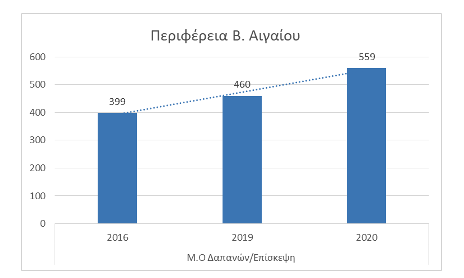
Chart 1: Average Expenditure per visit
Source: Bank of Greece - Edited by INSETE Intelligence
The data from Mytilini airport is particularly encouraging even though they are far from the good years of the previous two decades. Specifically for Mytilini, tourist arrivals with charter in July 2022 amounted to 10,932. Number improved for 2022 compared to 2020 and 2021. Tourists who arrived in Mytilini by charter flights come from seven European tourist markets, namely from the Netherlands, from England, from Belgium, from Denmark, from Poland, from Sweden, from Norway and from other countries.
Overall, however, the air arrivals of 2022, as can be seen in diagram 2, compared to those of 2021 are clearly improved and with an increasing trend. The specific diagram only concerns the arrivals of visitors to the island from foreign countries and gives an idea of the dynamics that could develop towards cultural tourism of any form other than literary such as spa, religious, rural, etc. after the appropriate information of the tourists.

Chart 2: Mytilini airport "Odysseas Elytis" 2022 Vs 2021 International passengers
Source: Fraport - FG Traffic Data Management 2022 traffic statistics
Sappho today can offer to the places she lived and created through a targeted strategic approach. For Greece, these places are Lefkada and especially Mytilini, as these are areas that have all the guarantees to be further highlighted through some specific actions such as:
- Highlighting the points mentioned in her poems and connected to her life.
- Guided tours with philological specialization to read her works to tourists with cultural interests
- Creation of a cultural park in Eresos with applications of philological activities, scientific days in the area, translation competitions of its works in different languages
- Connecting the poetess with the present through a cultural route that will highlight the traditions and elements of the region which at the same time could promote local consciousness and local identity. Her poems full of lyricism present the nature of the island which is still as rich and therefore offers itself to be highlighted.
- Sustainable development of the place with its interconnection with other routes that pertain to the huge cultural tradition of the island that begins with Alkaios and Sappho and reaches to our days with writers such as Eftaliotis, Myrivilis Elytis or artists such as Theophilos.
The highlighting of the places will be an example for the utilization of the historical heritage in other areas as well, such as the Sigriou Geoparko for a presentation of another form of tourism
CONCLUSIONS
Sappho is a role model, a woman whose work since ancient times has been a beacon that illuminates the spirit with its beauty and grace. She was loved because she highlighted the feminine nature and the power of strong friendship bonds. She is considered the poetess of Love, and even today she has an influence on the psyche of every person regardless of their sexual orientation. He put emotion at the base of literary production and highlighted it throughout time.
As it has been a model since ancient times, it gives the possibility to promote an alternative form of tourism and to show even more the history and culture of our country.
PHOTOS OF SAPFO TODAY
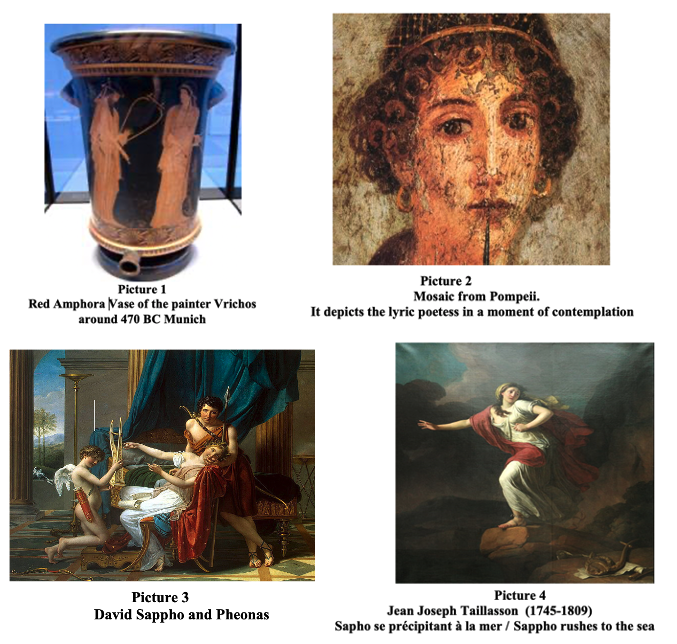
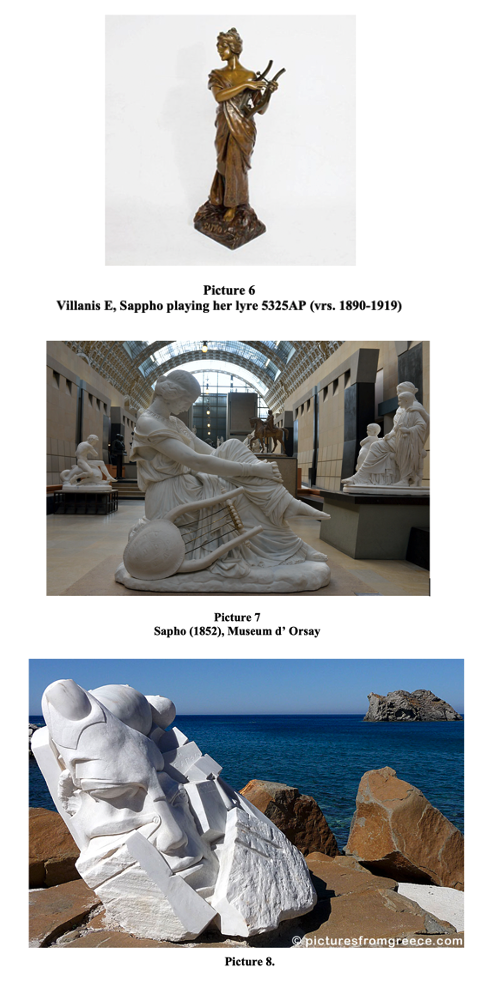
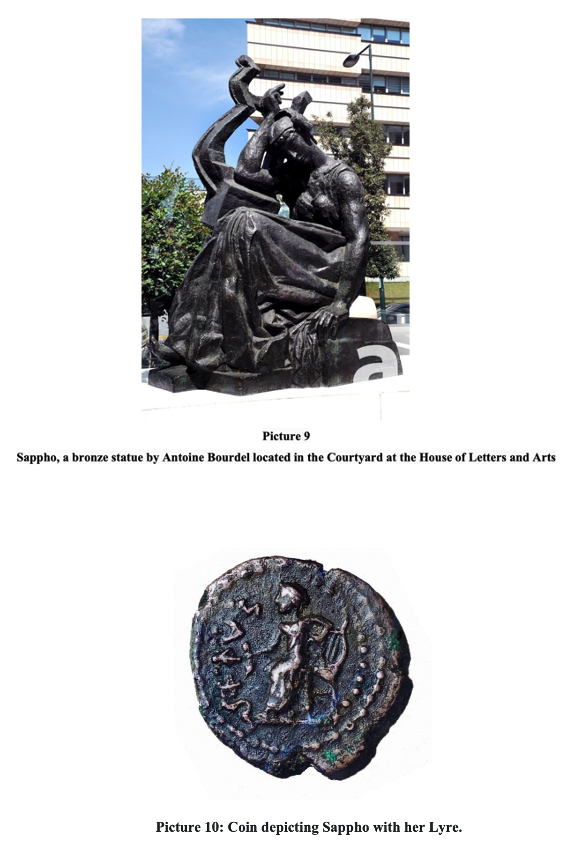
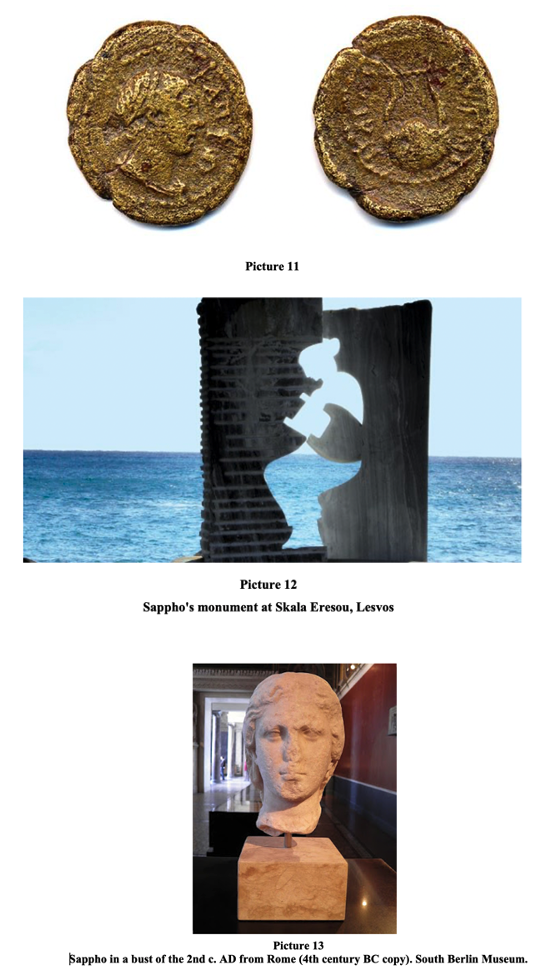
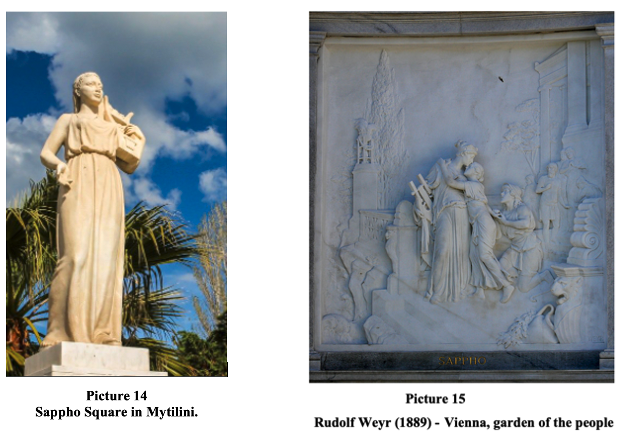
REFERENCES
- Rayor D. J. (1991). Sapphos Lyre. Archaic Lyric and Women Poets of Ancient Greece, Barkeley- Los Angeles: University of California press
- Woodard (2008). The Cambridge Companion to Greek Mythology Cambridge: Cambridge University Press, xvi, 536 pages, 16 unnumbered pages of plates : illustrations ; 24 cm. ISBN 9780521845205
- Zhang H., Fu X, Cai L., Lin L. (2014). Destination image and tourist loyalty a meta-analysis. Tourism Managment 40: 213-223. DOI: 10.1016/j.tourman.2013.06.006
- Anagnostaki-Tzavara E. (2000). Sappho of Love. Athens: Idmon
- Argyropoulou – Papadopoulou (2011). "Sappho and Odysseas Elytis ¨...in poetry as in dreams, no one grows old". Palmografos.com [7/11/2021]
- Bowra C. M. (2008). Ancient Greek lyric poetry. Alkman, Stisichoros, Alkaios, Sappho, fl. A' (trans.: Kazazis 1. N.), Athens, M.1.U.T
- Giannikou M. (2010). Sappho in ancient Greek and Byzantine literature. Doctoral thesis. Ioannina: Faculty of Philosophy, University of Ioannina
- Drakopoulou Th. (2015). Eresos "to all friendly spot" of Lesvos [on line]. lesvospost.com [13/12/2021]
- Kaggelaris, N. (2017) Sappho Fr. 105(a) LP – "Varnalis How Sappho's Maidens Mourn When She Loved Alcaeus (vv. 26-9): A New Reading of Their Intertextual Relationship." Philological 138: 43-6
- Kalantzis D. (2017). "Sappho: the woman who taught humanity the vocabulary of love".Online postmodern.[10/12/2021]
- Manola M. (2019). Literature-Culture-Tourism, (ed.). Athens: Tsiotras.
- Weigall A. (2001). Sappho Lesbia, the tenth muse. Athens: Enalios
- Takari K., (1995). Sappho, the tenth Muse, myth and reality. Athens: Kalentis
IMAGE WEBSITES
Picture 1: Red Amphora, Crater of the painter Vrichos around 470 BC. Munich, SOURCE: https://menoumemonaho.wixsite.com
Picture 2:Mosaic from Pompeii. It depicts the lyric poetess in a moment of contemplation, SOURCE: https://www.greelane.com
Picture 3 :Jean Joseph Taillasson (1745-1809) ,Sapho se précipitant à la mer / μετSappho rushes to the sea Source:https://www.hermitagemuseum.org,
Picture 4 Sourse: David Sappho και Pheonas (1809) https://musee.brest.fr/musee-accueil-3171.html /wps/portal/hermitage/?lng=el
Picture 5:Clesinger (1814-1883) , “ Sappho”,ΠΗΓΗ: http://www.artnet.com
Picture 6:Villanis E, Sappho playing her lyre 5325AP (vrs. 1890-1919), Source: http://www.artnet.com/artists/emmanuel-villanis/
Picture 7 :Pardier Source :Sapho ( 1852), Moυσείο d’ Orsay https://www.musee-orsay.fr/fr/oeuvres/sapho-16012
Picture 8. Source: https://www.picturesfromgreece.com/lesvos/statue-of-sappho-in-skala-eressos.html
Picture 9: Sappho, a bronze statue by Antoine Bourdelle located in the Courtyard of the House of Letters and Arts, Avenue Syngrou. SOURCE: 107-109 http://www.athenssculptures.com/2015/06/sappho.html
FIGURE 10 AND FIGURE 11: Coin depicting Sappho with her Lyre. SOURCE
https://www.filosofikilithos.gr/sapfo-i-megali-poiitria/
IMAGE 12:Sapphos Monument on the Stairs of Eresou Lesvos, SOURCE: https://www.google.com/search?q=%CE%BC%CE%BD%CE%B7%CE%BC
IMAGE 13: Sappho in a bust of the 2nd c. AD from Rome (4th century BC copy). South Berlin Museum. SOURCE https://homouniversalisgr.blogspot.com/2018/03/blog-post_93.html
ΕΙΚΟΝΑ 14:Πλατεία Σαπφούς στη Μυτιλήνη.ΠΗΓΗ: https://www.google.com/search?q=%CE%BC%CE%BD%CE%B7%CE%BC
Picture 15:Rudolf Weyr (1889) - Vienna, people's garden, SOURCE: https://homouniversalisgr.blogspot.com/2018/03/blog-post_93.html
[1] Aeolian form of her name
[2] LGBT+ (in English: LGBT+): A rights movement aiming to create a strong community and a society where there will be no discrimination based on sexuality. The acronym in both Greek and English refers to all people with different sexual preferences other than heterosexual
[3] The works mentioned above are in the appendix
[4] https://www.womensfestival.eu/programme/
[5] More information at https://insete.gr/studies/%CE%B5%CF%94.pdf
